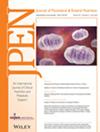Association between handgrip strength asymmetry and all-cause mortality in United States–based older adults: A cross-sectional study
Abstract
Background
Although handgrip strength is commonly measured in both hands for sarcopenia screening, the nonmaximum readings are frequently discarded. We aimed to evaluate whether handgrip strength asymmetry, in addition to weakness, could provide additional prognostic information in older adults.
Methods
Participants aged ≥60 years from the 2011–2014 National Health and Nutrition Examination Survey with available handgrip strength measurements were included. Study outcomes are all-cause and cardiovascular disease mortality. Participants were categorized into the weakness−/asymmetry− (reference), weakness−/asymmetry+, weakness+/asymmetry−, and weakness+/asymmetry+ groups based on the status of handgrip weakness and asymmetry.
Results
Overall, 3116 older adults (mean age, 69.47 years) were included. Weighted percentages of participants in the reference, weakness−/asymmetry+, weakness+/asymmetry−, and weakness+/asymmetry+ groups were 54.28%, 39.88%, 2.86%, and 2.97%, respectively. During a median follow-up of 79 months, 679 deaths (232 from cardiovascular causes) occurred. Compared with the reference group, hazard ratios (HRs) and 95% confidence intervals (CIs) for the weakness−/asymmetry+, weakness+/asymmetry−, and weakness+/asymmetry+ groups were 1.02 (95% CI 0.84–1.24), 1.57 (95% CI 1.09–2.26), and 2.34 (95% CI 1.47–3.71), respectively, for all-cause mortality (P for trend < 0.01) and 1.19 (95% CI 0.78–1.81), 1.22 (95% CI 0.54–2.78), and 2.30 (95% CI 1.20–4.39), respectively, for cardiovascular disease mortality (P for trend = 0.03). Subgroup analysis indicated anemia and diabetes significantly modified the associations between handgrip strength and/or weakness status with all-cause and cardiovascular disease mortality.
Conclusion
Handgrip strength asymmetry, in addition to weakness, provided additional prognostic information for all-cause and cardiovascular mortality in older adults in the United States.



 求助内容:
求助内容: 应助结果提醒方式:
应助结果提醒方式:


